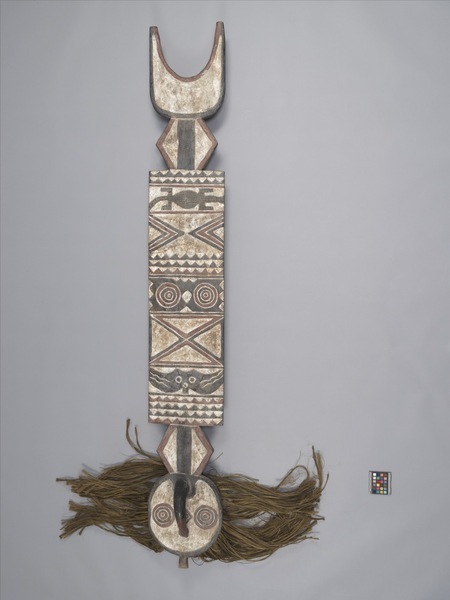Plank Mask Item Number: 3420/25 from the MOA: University of British Columbia


Description
Plank mask with circular face and tall, vertical superstructure. The face has two large concentric circle eyes, concentric diamond nose, and a small tubular mouth. Long plant fibre hair is attached across the back of the face mask, and hangs down. There is a black downward-curving projection attached at the centre of the forehead. Diamond-shaped panels connect both ends of the long rectangular board. The board is painted with geometric and zoomorphic shapes in black or dark red on a white background. Surmounted by a crescent-shape.
History Of Use
Adopted from the neighbouring Nunuma and Winiama peoples in the early twentieth century, the nwantantay masks are performed at initiation ceremonies, funerals, and secular entertainments. Vigorous, competitive performers grip a rope fastened along the mask’s back using their teeth, twisting and repeatedly tilting the towering plank, while twirling long fibre costumes to imitate their associated insect spirits. Composed of a circular face and upper plank, surmounted by a crescent moon, dense design elements proliferate with meaning: eyes reference owls; upturned beaks refer to hornbills, birds that are especially rich in nyama; checker-board patterns evoke the black and white hides sat on by elders and youths, respectively; while other symbols signify lineage affiliation.
Item History
- Made in Burkina Faso
- Owned by Richard Tchuemegne before February 5, 2020
- Received from Richard Tchuemegne (Seller), Michael O'Brian Family Foundation (Funding source) and Museum of Anthropology Exhibitions Budget (Funding source) on February 5, 2020
What
- Name
- Plank Mask
- Identification Number
- 3420/25
- Type of Item
- mask
- Material
- wood, paint and plant fibre
- Overall
- height 200.0 cm, width 28.5 cm, depth 20.0 cm
Who
- Culture
- Bwa
- Previous Owner
- Richard Tchuemegne
- Received from
- Richard Tchuemegne (Seller), Michael O'Brian Family Foundation (Funding source) and Museum of Anthropology Exhibitions Budget (Funding source)
Where
- Holding Institution
- MOA: University of British Columbia
- Made in
- Burkina Faso
When
- Ownership Date
- before February 5, 2020
- Acquisition Date
- on February 5, 2020
Other
- Condition
- fair
- Accession Number
- 3420/0025